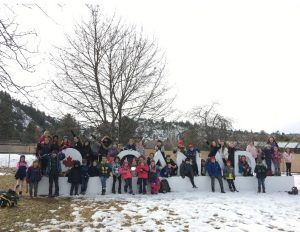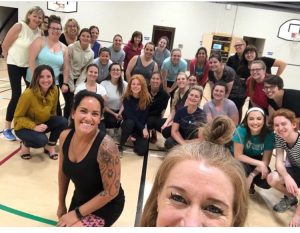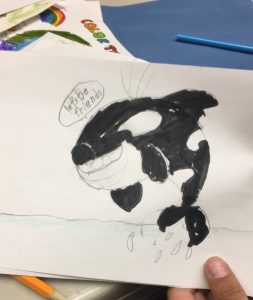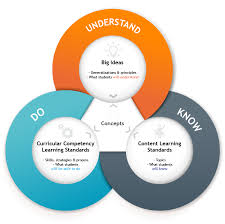While going through the photo album on my phone, I had a hard time trying to limit the photos I wanted to include in my E-portfolio. So while sifting through about 25 photos, I came to the decision that I would only add photos that were impactful moments in my life in my journey of becoming a teacher.
I’ve kept the photos in chronological order, as I think this information is best shared as a story. So In the beginning, I had the opportunity to do my volunteer hours in a grade 1/2 split classroom at Kamloops School of Arts, with Mrs. Jenn Coats as my mentor. She was an amazing resource for any time I had questions, and she made me feel comfortable in her classroom, always making me feel so welcome when I would come to volunteer. My class time with the class was spent on a field trip to the Kamloops Wildlife Park (as seen below), while going to the Wildlife Park with the class was amazing, being in Mrs. Coats’ class was so impactful to me because it was the first time I felt like I knew I was exactly where I was supposed to be. Unfortunately, I don’t have any photos of me in the classroom, so I have attached a photo of all of us cold, wet, and tired at the end of a fun day at the Wildlife Park!!

Field trip to the Kamloops Wildlife Park, March 2019
I started volunteering in the classroom right before I began working for SD73 in the After School Sports and Arts Initiative (ASSAI) programs, facilitating both visual art, and movement programs for at-risk youth in the Kamloops area. Through this job, I have had the opportunity to attend workshops and webinars, as well as hands-on experience working with students in a multitude of environments. In the movement programs, I have had the opportunity to teach groups of up to 30 students a variety of skills from soccer, basketball, badminton, tennis, and I’ve even had the luxury of being able to take some of the students rock climbing!

Rock climbing, March 2019. Can you spot me belaying?
Since starting with ASSAI, I have had the opportunity to learn about how sports and movement are separate concepts, and students do not need to be “good” at sports to keep moving! I find many students find this challenging because they tell themselves that they aren’t good at the traditional sports we do in gym class, so they feel that that crosses over to all sorts of movements. Personally, I never excelled in traditional sports which is kind of funny because now I’m the adult facilitating these programs, but I think that’s one of the reasons I enjoy facilitating these programs so much, and also why the students are drawn to the programs.

Hiking in Peterson Creek with students from Kamloops School of Arts in an ASSAI movement program, April 2019.
The programs are not mean to create amazing athletes, we run the programs to allow students opportunities and experiences that they may otherwise never have, all while creating a sense of community and support. Most, if not all of the time, we are playing games, giving high-fives, and encouraging one another in a fun and energetic environment, all while breaking down the construction that you need to be “good” at sports to stay active. Since starting with ASSAI, I have had opportunities

DANC3PL3Y workshop, May 2019.
to teach and practice yoga and mindfulness, go on hikes around Kamloops to learn and observe our environment, and learn DANC3PL3Y with the students of the after-school programs. The overarching idea behind the ASSAI movement programs is to allow students to opportunity to try new things, stay active, and create a sense of belonging.

A “kindness book” that was gifted to me by a student, May 2019
As I mentioned earlier, I also facilitate visual art programs throughout the district which has been equally as rewarding as I get to see children express themselves in such amazing and different ways throughout our 8-week programs. The art programs that I have facilitated are focused on working collaboratively with others to think of new ideas, pushing out of our comfort zones, mindfulness, and limiting the direct instruction that a teacher would give to allow students to work on pieces of art that are important to them. The biggest lesson I’ve learned from the art programs is that students are told what they should be doing all day, and when you give a student the opportunity to choose what they want to do they are both better behaved, and more passionate and interested in the work they are doing. One of my favourite things about the visual arts programs is the amount of artwork that has been given to me by students as a way for me to remember them.
Finally, I’m going to talk about the kindergarten class I was placed in for practicum, and my teacher mentor Mrs. Tessa Watson (photo removed). I consider myself the luckiest person in the program just based on the fact that I had such an incredible teacher mentor for my first practicum and such a diverse group of children in the classroom. Tessa was such an amazing resource for me during practicum and has continued to be a mentor for me since we finished practicum. From the relationship she and I built, the relationship I had with the class was equally as strong, and I continued to go visit the class multiple times since the practicum ended. During these visits, I was fortunate enough to help her with the students’ kindergarten assessments, as well as helping her get them all ready for their Christmas concert. I am so grateful for the time I had in her classroom for our first practicum, and I will never be able the thank Tessa enough for the support she gave me.






